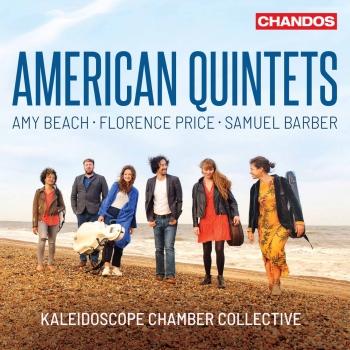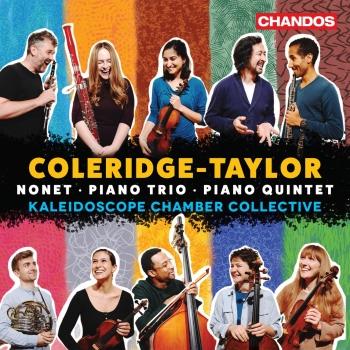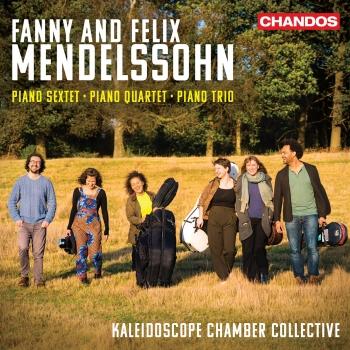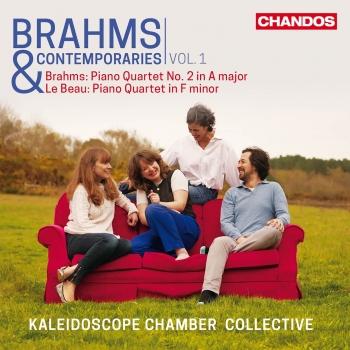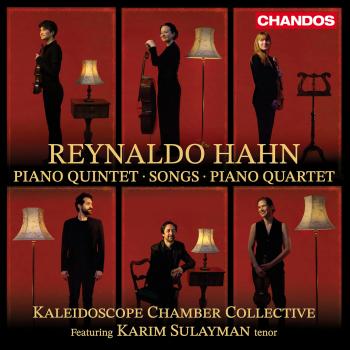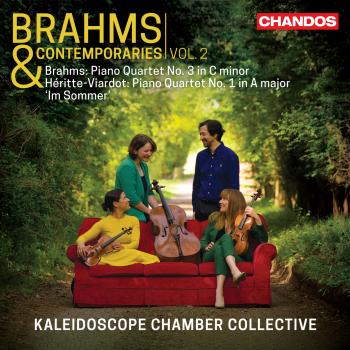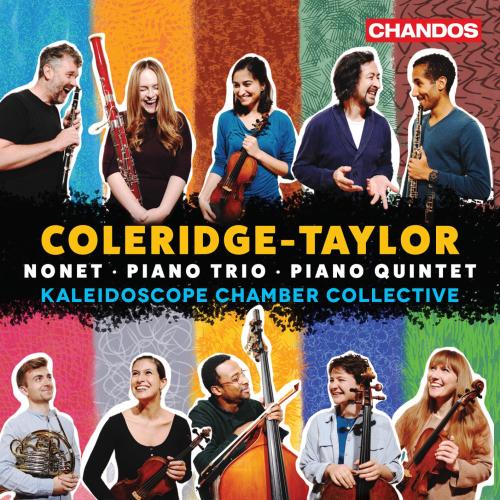
Samuel Coleridge-Taylor: Nonet, Piano Trio, Piano Quintet Kaleidoscope Chamber Collective
Album Info
Album Veröffentlichung:
2022
HRA-Veröffentlichung:
27.05.2022
Label: Chandos
Genre: Classical
Subgenre: Chamber Music
Interpret: Kaleidoscope Chamber Collective
Komponist: Samuel Coleridge-Taylor (1875-1905)
Das Album enthält Albumcover
- Samuel Coleridge-Taylor (1875 - 1912): Nonet, Op. 2 "Gradus ad Parnassum":
- 1 Coleridge-Taylor: Nonet, Op. 2 "Gradus ad Parnassum": I. Allegro moderato 09:14
- 2 Coleridge-Taylor: Nonet, Op. 2 "Gradus ad Parnassum": II. Andante con moto 06:03
- 3 Coleridge-Taylor: Nonet, Op. 2 "Gradus ad Parnassum": III. Scherzo 04:42
- 4 Coleridge-Taylor: Nonet, Op. 2 "Gradus ad Parnassum": IV. Finale 06:22
- Trio:
- 5 Coleridge-Taylor: Trio: I. Moderato 04:43
- 6 Coleridge-Taylor: Trio: II. Scherzo 01:40
- 7 Coleridge-Taylor: Trio: III. Finale 02:31
- Quintet, Op. 1:
- 8 Coleridge-Taylor: Quintet, Op. 1: I. Allegro con moto 10:05
- 9 Coleridge-Taylor: Quintet, Op. 1: II. Larghetto 07:37
- 10 Coleridge-Taylor: Quintet, Op. 1: III. Scherzo 04:52
- 11 Coleridge-Taylor: Quintet, Op. 1: IV. Allegro molto 05:46
Info zu Samuel Coleridge-Taylor: Nonet, Piano Trio, Piano Quintet
Samuel Coleridge-Taylor is best known for his cantata Hiawatha’s Wedding Feast, which brought him international success as well as propelling his career at home in the UK – success which was remarkable in stuffy late-Victorian England because of his mixed race and humble origins. Born out of wedlock to Daniel Taylor, a medical student from Sierra Leone, and Alice Holmans, Samuel was brought up by his mother and step-father, George Evans, a railway worker, in Croydon, south London.
The three pieces recorded here were all composed during his time as a student at the Royal College of Music. They were destined to remain unpublished during his lifetime, and indeed for some ninety years following his untimely death from pneumonia at the age of only thirty-seven.
The three chamber works by Samuel Coleridge-Taylor (1875 – 1912) recorded here all date from 1893 – 94, and were written during his time as a student at the Royal College of Music (RCM), in London. They were destined to remain unpublished during his lifetime, and indeed for some ninety years following his untimely death from pneumonia at the age of only thirty-seven. Thanks to the efforts of Patrick Meadows, the artistic director of Mallorca’s Deià International Music Festival, performing editions were eventually prepared from the surviving manuscripts – which had remained in the RCM’s archive – in the early 2000s, offering modern performers and audiences the chance for the first time to savour exactly how precocious the creative talents of the teenage Coleridge-Taylor had been before the popularity of his cantata Hiawatha’s Wedding Feast (first performed in 1898) propelled his mature music into the limelight on both sides of the Atlantic.
The international success which Coleridge- Taylor achieved was remarkable not solely because of his self-evident compositional prowess, but also because he was of mixed race and from humble origins. His father, Daniel Taylor, was a medical student from Sierra Leone, who studied at London’s King’s College Hospital and embarked on a relationship with a white woman, Alice Holmans, as a consequence of which Samuel was born (out of wedlock), in Holborn, central London. By this time Taylor had returned to his relatively well-off family in Africa, having in all probability never seen his son. Alice nevertheless adopted the surname Taylor, and (according to Samuel’s granddaughter) added Coleridge to her son’s name as a consequence of her admiration for the poet Samuel Taylor Coleridge. Alice soon afterwards moved with her father and son to the South London borough of Croydon, which Samuel would make his base for the remainder of his life. Alice subsequently married a railway worker, George Evans, and with him had three further children. As Samuel grew up and started to show his considerable musical talents, he found both his step-family and the local environment to be warmly supportive in developing his skills, at first in the shape of violin lessons and singing in local church choirs.
Kaleidoscope Chamber Collective
Tom Poster, artistic director
Kaleidoscope Chamber Collective
is a flexible ensemble of wonderful, joyful, kind, passionate musicians who can’t wait to share chamber music with you.
Like many musicians, we spend a lot of time worrying about the world - about inequality, prejudice, violence, bullying, divisive rhetoric. Chamber music has an extraordinary power to bring people together: it unites musicians as equals, and draws listeners in to its intimate, transportive world.
We love to devise creative and innovative programmes, to curate multi-concert series and residencies, and to showcase great music both familiar and lesser-known. Our diverse and brilliant team hopes also to be able to inspire and educate audiences of all generations in the joys of chamber music, and ultimately to bring a bit of happiness and unity to our currently rather fractured-seeming world.
Karim Sulayman
Lebanese-American tenor Karim Sulayman has garnered international attention as a sophisticated and versatile artist, praised for his “lucid, velvety tenor and pop-star charisma” (BBC Music Magazine). The 2019 Best Classical Solo Vocal GRAMMY® Award winner, he continues to earn acclaim for his original and innovative programming and recording projects, while regularly performing on the world’s stages in opera, orchestral concerts, recital and chamber music.
Recently Mr. Sulayman was presented by Carnegie Hall for a sold out solo recital debut followed immediately by the world premiere of his own multidisciplinary production, Unholy Wars, a baroque pasticcio centered around the Crusades and the Middle East, at Spoleto Festival USA. He’s also made recent debuts at Hamburg’s Elbphilharmonie, Stockholm’s Drottningholms Slottsteater, Houston Grand Opera, Australian Brandenburg Orchestra, and the Chicago, National and Pittsburgh Symphony Orchestras. He debuted at Wigmore Hall in concerts of French chamber music with his frequent collaborators, the Kaleidoscope Chamber Collective, which The Arts Desk named to its “Best Performances of 2022.”
Last season saw performances of his acclaimed program with guitarist Sean Shibe, Broken Branches, at Ravinia Festival, Schleswig-Holstein Festival, CAP-UCLA, Boston Celebrity Series and the Phillips Collection, and debuts at Opera Philadelphia (Unholy Wars) and New World Symphony (Britten’s Nocturne). He made his role debut as Grimoaldo in Handel’s Rodelinda (Hudson Hall), created the role of Crow in the world premiere of Layale Chaker/Lisa Schlesinger’s Ruinous Gods (Spoleto Festival USA), and debuted at the Royal Opera House, reprising the title role of Sarah Angliss/Ross Sutherland’s Giant, a role he created the previous year for the Aldeburgh Festival. This season and future engagements include the protagonist in the world premiere of David T. Little’s highly anticipated monodrama What Belongs to You (based on Garth Greenwell’s acclaimed novel), written for Sulayman and Alarm Will Sound and directed by Mark Morris, his role debut as Pelléas in Debussy’s Pelléas et Mélisande, a reprisal of his celebrated portrayal of Monteverdi’s L’Orfeo, and concerts at Park Avenue Armory, Wigmore Hall and Hong Kong’s Premiere Performances.
A dedicated chamber musician, Sulayman was a frequent participant at the Marlboro Music Festival in collaboration with co-directors and pianists Mitsuko Uchida and Richard Goode.. He has since been presented by many of the world’s leading chamber music festivals, collaborating frequently with groups like Eighth Blackbird and as a core member of the Kaleidoscope Chamber Collective. His concerts and recordings have been broadcast nationally and internationally on NPR, American Public Media, BBC Radio 3 and WDR 3.
Mr. Sulayman’s thought provoking and innovative programming is highlighted in his growing discography. He won the 2019 GRAMMY® Award for Best Classical Solo Vocal Album for his debut solo album, Songs of Orpheus (Avie Records), his original program of early Italian Baroque songs and arias. His second solo album, Where Only Stars Can Hear Us (Avie Records), an album of Schubert Lieder with fortepianist Yi-heng Yang was released in 2020 and debuted at #1 on the Billboard Traditional Classical Chart and has received widespread critical acclaim, including being named as “Critic’s Choice” by Opera News, and included on the New York Times’ “Best Classical Music of 2020.” His third album, Broken Branches (Pentatone) with Sean Shibe, debuted at #1 on the UK Classical Chart, and was named one of the Best Classical Music Albums of 2023 by the New York Times, Editor’s Choice by Gramophone Magazine, and was nominated for the 2024 GRAMMY® Award for Best Classical Solo Vocal album.
In November 2016, Karim created a social experiment/performance art piece called I Trust You, designed to build bridges in a divided political climate. A video version of this experiment went “viral” on the internet, and was honored as a prize winner in the My Hero Film Festival. He has been invited to give talks and hold open forums with student and adult groups about inclusion, empathy, healing from racism, and activism through the arts.
In other visual media, he is featured in the ARTE documentary Leonard Bernstein – A Genius Divided, which premiered throughout Europe in the summer of 2018 and was subsequently released on DVD. His performance of Bernstein’s Mass with the CSO was broadcast on PBS Great Performances in the spring of 2020, and in the fall of 2020 Karim appeared on the second season of the acclaimed series Dickinson on Apple TV+.
A native of Chicago, Karim’s musical education began with violin studies at age 3 which he continued through high school. He also spent years as a boy alto the Chicago Children’s Choir and was hand selected by Sir Georg Solti and Leonard Slatkin as a soloist with the Chicago Symphony Orchestra and the St. Louis Symphony. He graduated with highest honors from the Eastman School of Music where he worked in the Collegium Musicum under the tutelage of Paul O’Dette, and earned a Masters degree from Rice University. He later moved to Paris, France where he studied with renowned tenor/haute-contre, Howard Crook. He also studied improvisation at the Second City Training Center in Chicago.
Karim is passionate about his place in the Arts industry as someone who challenges audiences to think outside the box in a quest to maintain classical music’s relevance in a modern world, smashing the practice of treating old works as museum pieces. He enjoys educating the next generation of music students, encouraging them to think in this way while helping them cultivate their own unique voices. He hopes to make positive changes through thoughtful performance, arts advocacy and social justice that will impact generations to come.
Dieses Album enthält kein Booklet











